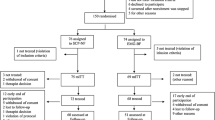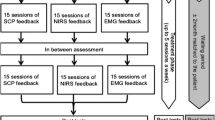Abstract
Among the different neuromodulation techniques, neurofeedback (NF) is gaining increasing interest in the treatment of children with attention-deficit/hyperactivity disorder (ADHD). In this article, a methodological framework is summarised considering the training as a neuro-behavioural treatment. Randomised controlled trials are selectively reviewed. Results from two smaller-scale studies are presented with the first study comprising a tomographic analysis over the course of a slow cortical potential (SCP) training and a correlational analysis of regulation skills and clinical outcome in children with ADHD. In the second study, ADHD-related behaviour was studied in children with tic disorder who either conducted a SCP training or a theta/low-beta (12–15 Hz) training (single-blind, randomised design). Both studies provide further evidence for the specificity of NF effects in ADHD. Based on these findings, a refined model of the mechanisms contributing to the efficacy of SCP training is developed. Despite a number of open questions concerning core mechanisms, moderators and mediators, NF (theta/beta and SCP) training seems to be on its way to become a valuable and ethically acceptable module in the treatment of children with ADHD.


Similar content being viewed by others
Notes
A comprehensive review about SCPs is provided in Birbaumer et al. (1990).
Originally, a SMR training was intended to be run. However, as a SMR training is recommended to reinforce a specific SMR spindle with duration of 0.25 s (Sherlin et al. 2011), which has not been done in our study, we decided to name the protocol 'theta/low-beta'.
References
Arnold LE, Lofthouse N, Hersch S, Pan X, Hurt E, Bates B, Kassouf K, Moone S, Grantier C (2012) EEG neurofeedback for ADHD: double-blind sham-controlled randomized pilot feasibility trial. J Atten Disord. doi:10.1177/1087054712446173
Arns M, Kenemans JL (2012) Neurofeedback in ADHD and insomnia: vigilance stabilization through sleep spindles and circadian networks. Neurosci Biobehav Rev. doi:10.1016/j.neubiorev.2012.10.006
Arns M, de Ridder S, Strehl U, Breteler M, Coenen A (2009) Efficacy of neurofeedback treatment in ADHD: the effects on inattention, impulsivity and hyperactivity: a meta-analysis. Clin EEG Neurosci 40:180–189
Bakhshayesh AR, Hänsch S, Wyschkon A, Rezai MJ, Esser G (2011) Neurofeedback in ADHD: a single-blind randomized controlled trial. Eur Child Adolesc Psychiatry 20(9):481–491
Banaschewski T, Brandeis D (2007) Annotation: what electrical brain activity tells us about brain function that other techniques cannot tell us: a child psychiatric perspective. J Child Psychol Psychiatry 48:415–435
Banaschewski T, Hollis C, Oosterlaan J, Roeyers H, Rubia K, Willcutt E, Taylor E (2005) Towards an understanding of unique and shared pathways in the psychopathophysiology of ADHD. Dev Sci 8(2):132–140
Banaschewski T, Neale BM, Rothenberger A, Roessner V (2007) Comorbidity of tic disorders & ADHD: conceptual and methodological considerations. Eur Child Adolesc Psychiatry 16(Suppl 1):5–14
Barry RJ, Clarke AR, Johnstone SJ (2003) A review of electrophysiology in attention deficit/hyperactivity disorder: I. Qualitative and quantitative electroencephalography. Clin Neurophysiol 114:171–183
Birbaumer N, Elbert T, Canavan AG, Rockstroh B (1990) Slow potentials of the cerebral cortex and behavior. Physiol Rev 70(1):1–41
Boutron I, Moher D, Douglas G, Altman G, Schulz F, Ravaud P (2008) Extending the CONSORT statement to randomized trials of nonpharmacologic treatment: explanation and elaboration. Ann Intern Med 148:295–310
Chambless DL, Ollendick TH (2001) Empirically supported psychological interventions: controversies and evidence. Annu Rev Psychol 52:685–716
Cohen JD (1988) Statistical power analysis for the behavioral sciences, 2nd edn. Erlbaum, Hillsdale
Döpfner M, Lehmkuhl G (2000) DISYPS-KJ: Diagnostik-System für psychische Störungen im Kindes- und Hugendalter. Hans Huber, Bern
Döpfner M, Schürmann S, Frölich J (2002) Therapieprogramm für kinder mit hyperkinetischem und oppositionellem problemverhalten (THOP). Beltz, Weinheim
Drechsler R, Straub M, Doehnert M, Heinrich H, Steinhausen HC, Brandeis D (2007) Controlled evaluation of a neurofeedback training of slow cortical potentials in children with attention deficit/hyperactivity disorder (ADHD). Behav Brain Funct 3:35
El-Sayed E, Larsson JO, Persson HE, Rydelius PA (2002) Altered cortical activity in children with attention-deficit/hyperactivity disorder during attentional load task. J Am Acad Child Adolesc Psychiatry 41:811–819
Faraone SV, Buitelaar J (2010) Comparing the efficacy of stimulants for ADHD in children and adolescents using meta-analysis. Eur Child Adolesc Psychiatry 19(4):353–364
Freedman B (1987) Equipoise and the ethics of clinical research. N Engl J Med 317:141–145
Gevensleben H, Holl B, Albrecht B, Vogel C, Schlamp D, Kratz O, Studer P, Rothenberger A, Moll GH, Heinrich H (2009a) Is neurofeedback an efficacious treatment for ADHD? A randomised controlled clinical trial. J Child Psychol Psychiatry 50:780–789
Gevensleben H, Holl B, Albrecht B, Schlamp D, Kratz O, Studer P, Wangler S, Rothenberger A, Moll GH, Heinrich H (2009b) Distinct EEG effects related to neurofeedback training in children with ADHD: a randomized controlled trial. Int J Psychophysiol 74:149–157
Gevensleben H, Holl B, Albrecht B, Schlamp D, Kratz O, Studer P, Rothenberger A, Moll GH, Heinrich H (2010) Neurofeedback training in children with ADHD: 6-month follow-up of a randomised controlled trial. Eur Child Adolesc Psychiatry 19(9):715–724
Gevensleben H, Moll GH, Rothenberger A, Heinrich H (2012) Neurofeedback in children with ADHD: validation and challenges. Expert Rev Neurother 12(4):447–460
Gevensleben H, Moll GH, Rothenberger A, Heinrich H (submitted) Neurofeedback in attention-deficit/hyperactivity disorder: different models and ways of application
Glannon W (2013) Neuromodulation, agency and autonomy. Brain Topogr. doi:10.1007/s10548-012-0269-3
Goldstein AP, Shipman WG (1961) Patient expectancies, symptom reduction and aspects of the initial psychotherapeutic interview. J Clin Psychol 17:129–133
Graham J, Banaschewski T, Buitelaar J, Coghill D, Danckaerts M, Dittmann RW, Döpfner M, Hamilton R, Hollis C, Holtmann M, Hulpke-Wette M, Lecendreux M, Rosenthal E, Rothenberger A, Santosh P, Sergeant J, Simonoff E, Sonuga-Barke E, Wong IC, Zuddas A, Steinhausen HC, Taylor E, For the European Guidelines Group (2011) European guidelines on managing adverse effects of medication for ADHD. Eur Child Adolesc Psychiatry 20:17–37
Heinrich H, Gevensleben H, Freisleder FJ, Moll GH, Rothenberger A (2004) Training of slow cortical potentials in ADHD: evidence for positive behavioral and neurophysiological effects. Biol Psychiatry 55(7):772–775
Heinrich H, Gevensleben H, Strehl U (2007) Annotation: neurofeedback: train your brain to train behaviour. J Child Psychol Psychiatry 48(1):3–16
Herbert JD, Gaudiano BA (2005) Moving from empirically supported treatment lists to practice guidelines in psychotherapy: the role of the placebo concept. J Clin Psychol 61(7):893–908
Hinterberger T, Veit R, Strehl U, Trevorrow T, Erb M, Kotchoubey B, Flor H, Birbaumer N (2003) Brain areas activated in fMRI during self-regulation of slow cortical potentials (SCPs). Exp Brain Res 152(1):113–122
Kleemeyer M (2010) Self-regulation of slow cortical potentials in children with attention-deficit/hyperactivity disorder: a tomographic analysis over the course of a neurofeedback-training. Master Thesis, University of Bremen
Lansbergen MM, van Dongen-Boomsma M, Buitelaar JK, Slaats-Willemse D (2011) ADHD and EEG-neurofeedback: a double-blind randomized placebo-controlled feasibility study. J Neural Transm 118(2):275–284
Leckman JF, Riddle MA, Hardin MT, Ort SI, Swartz KL, Stevenson J, Cohen DJ (1989) The Yale Global Tic Severity Scale: initial testing of a clinician-rated scale of tic severity. J Am Acad Child Adolesc Psychiatry 28(4):566–573
Leckman JF, Vaccarino FM, Kalanithi PS, Rothenberger A (2006) Annotation: tourette syndrome: a relentless drumbeat–driven by misguided brain oscillations. J Child Psychol Psychiatry 47(6):537–550
Leins U, Goth G, Hinterberger T, Klinger C, Rumpf N, Strehl U (2007) Neurofeedback for children with ADHD: a comparison of SCP and theta/beta protocols. Appl Psychophysiol Biofeedback 32(2):73–88
Liechti M, Maurizio S, Heinrich H, Jäncke L, Meier L, Steinhausen HC, Walitza S, Drechsler R, Brandeis D (2012) First clinical trial of tomographic neurofeedback in attention-deficit/hyperactivity disorder: evaluation of voluntary cortical control. Clin Neurophysiol 123(10):1989–2005
Liechti MD, Valko L, Müller UC, Döhnert M, Drechsler R, Steinhausen HC, Brandeis D (2013) Diagnostic value of resting electroencephalogram in attention-deficit/hyperactivity disorder across the lifespan. Brain Topogr 26(1):135–151
Lofthouse N, Arnold L, Hurt E (2010) A comment on Sherlin, Arns, Lubar, and Sokhadze. J Neutother 14(4):301–306
Loo SK, Barkley RA (2005) Clinical utility of EEG in attention deficit hyperactivity disorder. Appl Neuropsychol 12(2):64–76
Messerotti Benvenuti S, Buodo G, Leone V, Palomba D (2011) Neurofeedback training for tourette syndrome: an uncontrolled single case study. Appl Psychophysiol Biofeedback 36(4):281–288
Moll GH, Heinrich H, Trott GE, Wirth S, Bock N, Rothenberger A (2001) Children with comorbid attention-deficit-hyperactivity disorder and tic disorder: evidence for additive inhibitory deficits within the motor system. Ann Neurol 49(3):393–396
Omer H, London P (1989) Signal and noise in psychotherapy. The role and control of non-specific factors. Br J Psychiatry 155:239–245
Pascual-Marqui RD (2002) Standardized low-resolution brain electromagnetic tomography (sLORETA): technical details. Methods Find Exp Clin Pharmacol 24(Suppl D):5–12
Pelham WE Jr, Fabiano GA (2008) Evidence-based psychosocial treatments for attention-deficit/hyperactivity disorder. J Clin Child Adolesc Psychol 37(1):184–214
Plotkin WB (1980) The role of attributions of responsibility in the facilitation of unusual experiential states during alpha training: an analysis of the biofeedback placebo effect. J Abnorm Psychol 89(1):67–78
Polanczyk G, de Lima MS, Horta BL, Biederman J, Rohde LA (2007) The worldwide prevalence of ADHD: a systematic review and metaregression analysis. Am J Psychiatry 164(6):942–948
Radenbach K, Wiesemann C (2010) Risiko und Belastung als Kriterien der Zulässigkeit von Forschung mit Kindern und Jugendlichen. In: Marckmann G, Niethammer D (eds) Ethische Aspekte pädiatrischer Forschung. Deutscher Ärzte-Verlag, Köln, pp 37–49
Roberts LW, Lauriello J, Geppert C, Keith SJ (2001) Placebos and paradoxes in psychiatric research: an ethics perspective. Biol Psychiatry 49:887–893
Roessner V, Schoenefeld K, Buse J, Wanderer S, Rothenberger A (2012) Therapy of tic disorders. Z Kinder Jugendpsychiatr Psychother 40(4):217–236
Ros T, Munneke MA, Ruge D, Gruzelier JH, Rothwell JC (2010) Endogenous control of waking brain rhythms induces neuroplasticity in humans. Eur J Neurosci 31(4):770–778
Ros T, Théberge J, Frewen PA, Kluetsch R, Densmore M, Calhoun VD, Lanius RA (2013) Mind over chatter: plastic up-regulation of the fMRI salience network directly after EEG neurofeedback. Neuroimage 65:324–335
Rothenberger A, Roessner V (2013) The phenomenology of attention-deficit/hyperactivity disorder in Tourette syndrome. In: Martino D, Leckman JF (eds) Tourette syndrome. Oxford Press, New York
Sergeant JA (2005) Modeling attention-deficit/hyperactivity disorder: a critical appraisal of the cognitive-energetic model. Biol Psychiatry 57:1248–1255
Sherlin LH, Arns M, Lubar J, Heinrich H, Kerson C, Strehl U, Sterman MB (2011) Neurofeedback and basic learning theory: implications for research and practice. Journal of Neurotherapy 15:292–304
Strehl U, Leins U, Goth G, Klinger C, Hinterberger T, Birbaumer N (2006) Self-regulation of slow cortical potentials: a new treatment for children with attention-deficit/hyperactivity disorder. Pediatrics 118(5):e1530–e1540
Tansey MA (1986) A simple and a complex tic (Gilles de la Tourette’s syndrome): their response to EEG sensorimotor rhythm biofeedback training. Int J Psychophysiol 4(2):91–97
Taylor E, Döpfner M, Sergeant J, Asherson P, Banaschewski T, Buitelaar J, Coghill D, Danckaerts M, Rothenberger A, Sonuga-Barke E, Steinhausen HC, Zuddas A (2004) European clinical guidelines for hyperkinetic disorder: first upgrade. Eur Child Adolesc Psychiatry 13(Suppl 1):I7–I30
Wangler S, Gevensleben H, Albrecht B, Studer P, Rothenberger A, Moll GH, Heinrich H (2011) Neurofeedback in children with ADHD: specific event-related potential findings of a randomized controlled trial. Clin Neurophysiol 122(5):942–950
Acknowledgments
The studies included in this paper were supported by the German Research Foundation (study I, HE 4536/2, MO 726/2) and the Tourette Gesellschaft Deutschland (study II). The authors thank the participating families (particularly the children) and all colleagues and students contributing to these studies.
Author information
Authors and Affiliations
Corresponding author
Additional information
This is one of several papers published together in Brain Topography on the “Special Topic: Clinical and Ethical Implications of Neuromodulation Techniques”.
Electronic supplementary material
Below is the link to the electronic supplementary material.
Rights and permissions
About this article
Cite this article
Gevensleben, H., Kleemeyer, M., Rothenberger, L.G. et al. Neurofeedback in ADHD: Further Pieces of the Puzzle. Brain Topogr 27, 20–32 (2014). https://doi.org/10.1007/s10548-013-0285-y
Received:
Accepted:
Published:
Issue Date:
DOI: https://doi.org/10.1007/s10548-013-0285-y




